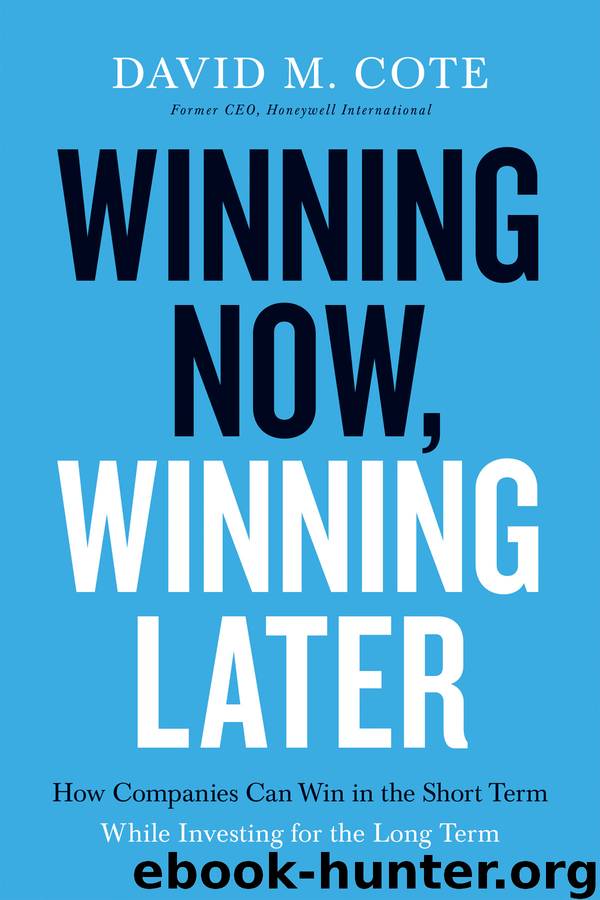Winning Now, Winning Later by David M. Cote

Author:David M. Cote
Language: eng
Format: epub
Publisher: Harpercollins Leadership
Published: 2020-04-16T16:00:00+00:00
TIGHTEN UP TALENT MANAGEMENT
You might think improving leadership quality is pretty simple: just fire all of your weak, underperforming leaders and replace them with better people. You can probably enhance your leadership cadre with this approach, but in the process you’ll disrupt the organization by forcing too much change all at once. As I mentioned in the last chapter, we transitioned out several top leaders during my first few years at Honeywell, but it wasn’t a radical house-cleaning. We tried to keep as many existing leaders in place as possible to maintain a sense of stability and to allow our organization the time it needed to absorb the effects of these transitions.
Gradual change has always seemed sound to me as a management principle, but it was absolutely essential for us when it came to personnel matters. As you’ll recall from the introduction, Honeywell was in disarray when I arrived thanks to our failed merger with General Electric. For about a year, while the two companies awaited regulatory approval for the deal, leaders at General Electric informally ran Honeywell, even though they didn’t yet own it. The result was chaos. General Electric told entire parts of our business that they would be eliminated through restructuring once the deal went through. As a result, huge swaths of our middle management and senior leadership corps ran for the exits. Many of those who stayed were biding their time, waiting for the deal to go through so that they could get a big payoff but contributing only lackluster performance. Once the deal failed to materialize, the company remained adrift under the stewardship of a temporary CEO, with no clear strategy. In addition, the company was beset by cultural warfare, as described in chapter 5. In this context, about a quarter of our leadership positions were unfilled when I arrived. My goal was to bring stability as well as change. The last thing we needed was more shocks to our system in the form of a wholesale replacement of our leadership ranks. Many investors didn’t see it this way; they wondered why I wasn’t bringing in a new leadership team, and suspected that either I didn’t have the chops to do my job or that other talented leaders didn’t want to work for me. I knew otherwise. We desperately needed to improve the quality of our leadership, but we would do it gradually.
The good news was that improvements in leadership quality didn’t require sweeping gestures. As we found, tightening up our people processes so that they actually worked went a long way. I described some of the changes we made to our management resource review (MRR) in the last chapter, including an annual meeting I held with my staff in which we exchanged views on our company’s top four hundred leaders. The more fundamental change we made was to enhance the intensity and rigor of MRRs generally. When I arrived, leaders were going through the motions of completing MRRs, but as with our strategic planning and our accounting, it wasn’t a meaningful process.
Download
This site does not store any files on its server. We only index and link to content provided by other sites. Please contact the content providers to delete copyright contents if any and email us, we'll remove relevant links or contents immediately.
Bad Blood by John Carreyrou(5768)
Principles: Life and Work by Ray Dalio(5322)
Rich Dad Poor Dad by Robert T. Kiyosaki(5148)
Management Strategies for the Cloud Revolution: How Cloud Computing Is Transforming Business and Why You Can't Afford to Be Left Behind by Charles Babcock(4130)
The Confidence Code by Katty Kay(3566)
Thinking in Bets by Annie Duke(3531)
American Kingpin by Nick Bilton(2970)
Playing to Win_ How Strategy Really Works by A.G. Lafley & Roger L. Martin(2950)
Delivering Happiness by Tony Hsieh(2922)
Project Animal Farm: An Accidental Journey into the Secret World of Farming and the Truth About Our Food by Sonia Faruqi(2660)
Brotopia by Emily Chang(2591)
I Live in the Future & Here's How It Works by Nick Bilton(2524)
Mastering Bitcoin: Programming the Open Blockchain by Andreas M. Antonopoulos(2509)
The Content Trap by Bharat Anand(2493)
The Power of Habit by Charles Duhigg(2489)
The Marketing Plan Handbook: Develop Big-Picture Marketing Plans for Pennies on the Dollar by Robert W. Bly(2413)
The Tyranny of Metrics by Jerry Z. Muller(2401)
Building a StoryBrand by Donald Miller(2360)
Applied Empathy by Michael Ventura(2328)
